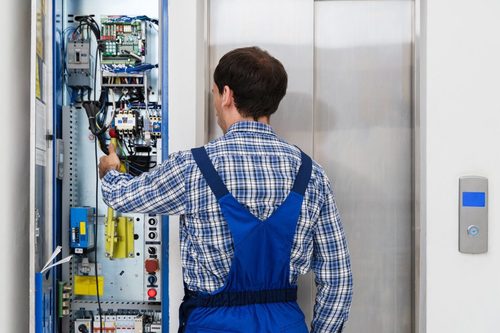Comprehensive Guide to Elevator Equipments and Their Maintenance
Browsing the intricate globe of lift systems and their upkeep is a job that requires precision and expertise. From the various kinds of lift systems in use to the careful adherence to safety guidelines, the upkeep of these upright transportation gadgets is a multifaceted venture.
Kinds of Elevator Solutions
Lift systems come in different kinds, each developed to match specific building demands and customer needs. The most typical kinds consist of hydraulic elevators, grip lifts, machine-room-less elevators, and vacuum cleaner lifts. Hydraulic lifts are optimal for low-rise structures and make use of a hydraulic piston to relocate the elevator cars and truck. Grip elevators, on the other hand, are much more fit for skyscraper structures and use steel ropes and weights to move the auto. Machine-room-less elevators are a space-saving option as they do not need a separate maker area for the lift equipment. Vacuum cleaner elevators, an extra modern-day innovation, use air pressure differentials to move the automobile within a transparent tube.
Each sort of lift system has its very own advantages and downsides, making it critical for structure proprietors and designers to very carefully consider their certain needs before picking one of the most appropriate choice. Elements such as building elevation, room accessibility, energy performance, and budget restraints all play a substantial function in identifying the most effective lift system for a specific building.
Usual Upkeep Concerns
Regular maintenance of elevator systems is vital to guarantee smooth operation and extend their life expectancy. In spite of routine upkeep, lift systems can still come across typical maintenance issues that need to be quickly dealt with to avoid interruptions in service. Regular examinations and aggressive upkeep can assist determine and deal with these common maintenance issues prior to they intensify and affect the overall efficiency of the lift system.
Security Regulations and Compliance
Abiding by rigorous security policies and guaranteeing conformity with sector requirements are critical for keeping the functional integrity of lift systems. Lifts undergo a thorough set of safety laws to secure passengers, upkeep workers, and the general public. Governing bodies such as the Occupational Security and Wellness Management (OSHA) in the USA and the European Lift Association (ELA) in Europe establish standards that cover numerous elements of elevator design, maintenance, installment, and procedure.
Conformity with these regulations is not just a lawful demand yet likewise an ethical obligation for building proprietors and elevator maintenance firms. Failure to satisfy safety requirements can cause fines, legal responsibilities, and, most importantly, jeopardize the security of people using the lift. Normal evaluations, maintenance checks, and adherence to safety and security protocols detailed in the laws are important to make sure the secure and efficient procedure of lift systems. By prioritizing safety guidelines and conformity, stakeholders can promote the trust of the general public and mitigate prospective dangers related to lift usage.
Ideal Practices for Maintenance

Structure owners should also consider investing in modernization upgrades to improve the efficiency and safety and security of their elevator systems. By adhering to these best techniques, elevator systems can run smoothly and securely, providing reliable upright transportation for passengers.

Advanced Technologies for Performance
Applying sophisticated modern technologies in lift systems can dramatically enhance operational efficiency and traveler experience. lift maintenance london. Among the crucial improvements in elevator innovation is the introduction of location control systems. These systems permit travelers to input their preferred flooring prior to getting in the elevator, which after that guides them to the most effective automobile. By enhancing and decreasing unnecessary quits traveling paths, destination control systems decrease wait times and blockage in high-traffic structures.
In addition, the combination of clever sensors and anticipating maintenance capacities has revolutionized lift maintenance. These sensors can detect possible issues prior to they escalate, allowing aggressive upkeep interventions and decreasing downtime. Additionally, the usage of energy-efficient components and regenerative drives helps in reducing power intake and operating expense in lift systems.
Furthermore, the application of cloud-based monitoring and remote diagnostics enables for real-time monitoring of lift efficiency and instant troubleshooting of any type of breakdowns. This aggressive approach not just boosts system integrity yet also enhances you could look here the total individual experience by making certain smooth and continuous lift operations.
Final Thought
Finally, recognizing the different kinds of elevator systems, typical upkeep issues, safety guidelines, ideal maintenance techniques, and advanced technologies for useful site effectiveness is vital for making certain the smooth operation of elevators. By adhering to safety policies and implementing best practices for upkeep, building owners can prolong the lifespan of their elevator systems and guarantee the safety of travelers. It is very important to stay updated on the most recent developments in elevator modern technology to improve efficiency and dependability.
The most typical types include hydraulic elevators, grip lifts, machine-room-less lifts, and vacuum elevators. Hydraulic elevators are perfect for low-rise buildings and make use of a hydraulic piston to relocate the lift cars and truck. Machine-room-less lifts are a space-saving choice as they do not require a different equipment area for the elevator machinery. Normal examinations and aggressive maintenance can help determine and solve these typical maintenance concerns prior to they intensify and impact the total efficiency of the elevator system.
